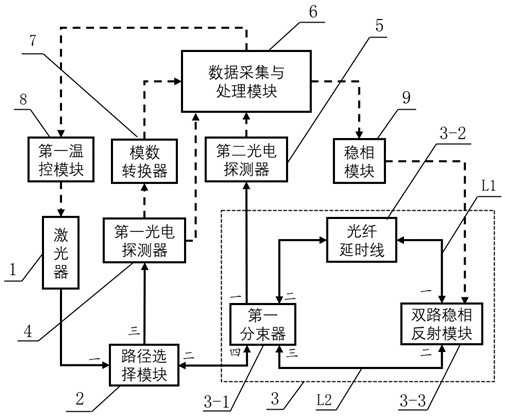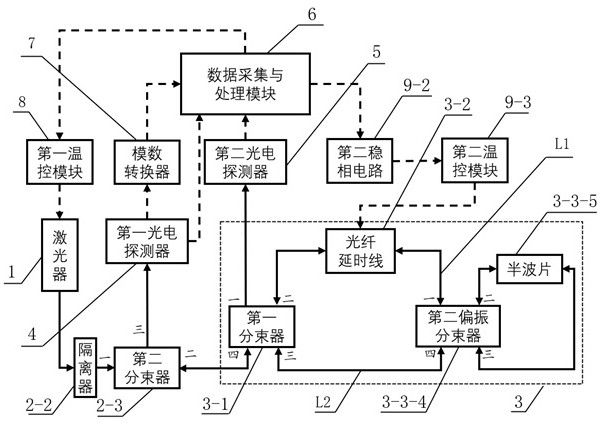Quantum random number generator based on laser phase noise
A quantum random number and phase noise technology, applied in random number generators, quantum computers, instruments, etc., can solve problems such as affecting interference stability, increasing system cost, reducing polarization consistency, etc., to improve interference stability, improve Effects of stability and usability
- Summary
- Abstract
- Description
- Claims
- Application Information
AI Technical Summary
Problems solved by technology
Method used
Image
Examples
Embodiment 1
The structure of the quantum random number generator is as follows: the long and short arm fibers L1 and L2 of the interferometer 3 are both single-mode fibers; the dual-channel phase stabilization reflection module 3-3 includes a fiber phase shifter 3-3-1 , the first polarization beam splitter 3-3-2 and the first Faraday rotator 3-3-3; the phase stabilization module 9 is the first phase stabilization circuit 9-1, which is used to generate a phase modulation voltage to shift the phase of the fiber The first port of the first polarization beam splitter 3-3-2 is connected to a port of the optical fiber phase shifter 3-3-1; the optical fiber phase shifter 3- The other port of 3-1 and the fourth port of the first polarization beam splitter 3-3-2 are used as the first port and the second port of the dual phase stable reflection module 3-3 respectively; the first polarization beam splitter The second port and the third port of the first Faraday rotator 3-3-2 are respectively connecte...
Embodiment 2
The structure of the quantum random number generator is as follows: the long and short arm fibers L1 and L2 of the interferometer 3 are both polarization-maintaining fibers; the two-way phase stabilization reflection module 3-3 includes a second polarization beam splitter 3-3 -4 and half-wave plate 3-3-5; the phase stabilization module 9 includes a second phase stabilization circuit 9-2 and a second temperature control module 9-3, which are used for temperature control of the optical fiber delay line 3-2. Phase modulation is performed; the first port and the fourth port of the second polarization beam splitter 3-3-4 are respectively used as the first port and the second port of the dual-channel phase stable reflection module 3-3; the second polarization The second port and the third port of the beam splitter 3-3-4 are respectively connected with the two ports of the half-wave plate 3-3-5 through polarization maintaining fibers to form a second Sagnac ring; the half-wave plate Th...
Embodiment 3
[0033] The specific process of the third embodiment includes:
[0034] S1 exits from the second port of the first beam splitter 3-1, wherein S1 propagates along the long-arm fiber L1 and the slow axis of the fiber delay line 3-2 and then reaches the first port of the third polarization beam splitter 3-3-6. A port, exiting from its third port, propagates counterclockwise within the third Sagnac ring along the slow axis of the polarization maintaining fiber ring 3-3-7 to the second of the third polarization beam splitter 3-3-6 The port, then exits the first port, the polarization direction is rotated by 90°, enters the long arm fiber L1 of the interferometer 3 and the fiber delay line 3-2 propagates along the fast axis of the polarization maintaining fiber, and finally reaches the first beam splitter 3- 1 for the second port.
[0035] S2' exits from the third port of the first beam splitter 3-1, propagates along the slow axis of the short-arm fiber L2, and then reaches the four...
PUM
 Login to View More
Login to View More Abstract
Description
Claims
Application Information
 Login to View More
Login to View More - R&D
- Intellectual Property
- Life Sciences
- Materials
- Tech Scout
- Unparalleled Data Quality
- Higher Quality Content
- 60% Fewer Hallucinations
Browse by: Latest US Patents, China's latest patents, Technical Efficacy Thesaurus, Application Domain, Technology Topic, Popular Technical Reports.
© 2025 PatSnap. All rights reserved.Legal|Privacy policy|Modern Slavery Act Transparency Statement|Sitemap|About US| Contact US: help@patsnap.com



